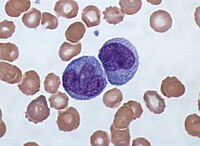
Photo from wikipedia
Objectives The immunologic profile and opportunistic viral DNA increase were monitored in Italian patients with COVID-19 in order to identity markers of disease severity. Methods A total of 104 patients… Click to show full abstract
Objectives The immunologic profile and opportunistic viral DNA increase were monitored in Italian patients with COVID-19 in order to identity markers of disease severity. Methods A total of 104 patients infected with SARS-CoV-2 were evaluated in the study. Of them, 42/104 (40.4%) were hospitalized in an intensive care unit (ICU) and 62/104(59.6%) in a sub-intensive care unit (SICU). Human cytomegalovirus (HCMV) and Epstein-Barr virus (EBV), Parvovirus B19 and Human Herpesvirus 6 virus reactivations were determined by real-time PCR, and lymphocyte subpopulation counts were determined by flow cytometry. Results Among opportunistic viruses, only EBV was consistently detected. EBV DNA was observed in 40/42 (95.2%) of the ICU patients and in 51/61 (83.6%) of the SICU patients. Comparing the two groups of patients, the EBV DNA median level among ICU patients was significantly higher than that observed in SICU patients.In parallel, a significant reduction of CD8 T cell and NK count in ICU patients as compared with SICU patients was observed (p < 0.05). In contrast, B cell count was significantly increased in ICU patients (p = 0.0172). Conclusions A correlation between reduced CD8+ T cells and NK counts, EBV DNA levelsand COVID-19 severity was observed. Other opportunistic viral infections were not observed. The relationship between EBV load and COVID-19 severity should be further evaluated in longitudinal studies.
Journal Title: International Journal of Infectious Diseases
Year Published: 2020
Link to full text (if available)
Share on Social Media: Sign Up to like & get
recommendations!